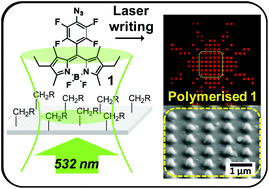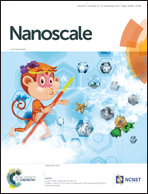2D and 3D surface photopatterning via laser-promoted homopolymerization of a perfluorophenyl azide-substituted BODIPY†
Abstract
An innovative photopatterning process is described that allows, in a single laser-promoted operation, the covalent attachment of a molecule on a surface (2D patterning – xy dimensions) and its photopolymerization to grow micro-/nanostructures with spatial control in a third z-dimension. The surface patterning process, based on nitrene reactivity, was harnessed using the highly fluorescent azide-substituted boron difluoride dipyrromethene (BODIPY) 1 that was prepared in a single synthetic step from the parent pentafluorophenyl BODIPY on reacting with NaN3. Using the laser of a fluorescence microscope (375 nm or 532 nm) 1 could be grafted on adapted surfaces and then homopolymerised. In this study we show that using glass coverslips coated with PEG/high density alkyne groups (density of ∼1 × 1014 per cm2), the patterning process was much more spatially confined than when using PEG only coating. Varying the irradiation time (1 to 15 s) or laser power (0.14–3.53 μW) allowed variation of the amount of deposited BODIPY to afford, in the extreme case, pillars of a height up to 800 nm. AFM and MS studies revealed that the nano/microstructures were formed of particles of photopolymerized 1 having a mean diameter of ca. 30 nm. The emission spectra and fluorescence lifetimes for the patterned structures were measured, revealing a red-shift (from ∼560 nm up to 620 nm) of the maximum emission and a shortening (from ∼6 ns to 0.8 ns) of the fluorescence lifetimes in areas where the density of BODIPY is high. As an application of the patterning process, a figure formed of 136 dots/pillars was prepared. The confocal hyperspectral fluorescence image revealed that the figure is clearly resolved and constituted by highly photoluminescent red dots whose fluorescence intensities and emission color proved to be highly reproducible. SEM and AFM studies showed that the luminescent dots were pillars with a conical shape, an average height of 710 ± 28 nm and a FWHM of 400 ± 20 nm.



 Please wait while we load your content...
Please wait while we load your content...